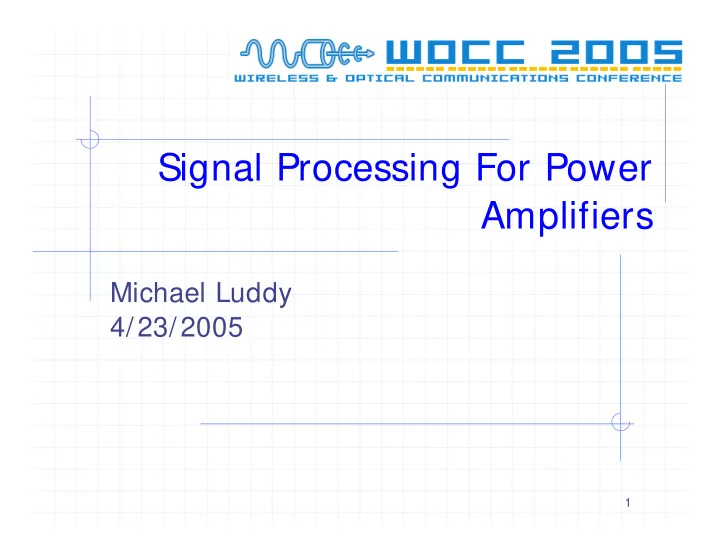

Signal Processing For Power Amplifiers Michael Luddy 4/23/2005 1
Outline Motivation and Requirements � Cost impact Architecture and Algorithms � CFR � DPD & MEC � MEQ Simulation � Environment � Results Emerging Solutions and Future Directions � Design Directions � Conclusions 2
Motivation Motivation and Requirements � Cost impact Architecture and Algorithms � CFR � DPD & MEC � MEQ Simulation � Environment � Results Emerging Solutions and Future Directions � Design Directions � Conclusions 3
The Need For Linearization PA performance effects Carrier Expenses Digital Linearization techniques enable: � CapEx Reduction due to lower cost BTS (10-15%) � Remove gain stages, circuit hand tuning � OpEx reduction due to higher efficiency PA � Current designs lose ~ 85% of PA power as heat � Annual electrical costs avg ~ $2500 per BTS Performance targets � Double efficiency of PA (from 12% to 25%) � Increase ACLR by > 30 dB � Better than -45 dBc ACLR � Improve OBO by more than 4 dB � Less than 17.5% EVM 4
Architecture and Algorithms Motivation and Requirements Cost impact � Higher density systems � Architecture and Algorithms Crest Factor Reduction CFR � Digital Pre-Distortion & Memory Effects Comp DPD & MEC � Modulator Equalization MEQ � Simulation Environment � Results � Emerging Solutions and Future Directions � Design Directions � Conclusions 5
Signal Processing Features Crest factor reduction (CFR) � Provides more than 6dB improvement in PAR by reducing peak excursions � Goodness by measuring EVM, PCDE and ACLR Digital pre-distortion (DPD) � Correction of gain non-linearity � Memory effects (temperature) correction Modulator Equalization (MEQ) corrects impairments in analog modulator � � Phase and gain imbalance, DC offsets 6
Architecture Overview Digital Signal Processing From baseband Multicarrier combiner Signal Path DACs BPF Crest Factor PA Reduction Digital Pre-Distortion From LO Measurem Memory effects ent ADCs compensation BPF Modulation Equalization Error Measurement Thermo ADC Adaptation Engine 7
CFR Principles ≤ Signal from MCC Signal to INF Comparing With Clipping Threshold > Clipping Filtering 2 max( x ) CF = 10 log ( 10 2 E [ x ] Crest Factor Reduction ⎛ ⎞ 2 2 max( E [ e ]) E [ e ] ⎜ ⎟ = EVM RMS = k PCDE 10 log ⎜ ⎟ 10 ' 2 ⎝ ⎠ E [ r ] 2 E [ r ] When magnitude exceeds threshold, CFR is performed. The basis of most CFR algorithms is clipping + filtering 8
Overview of CFR Algorithms Algorithm ACLR EVM PCDE COMMENTS Clipping High Low Medium Simplest technique. Peak Medium Medium Medium Window length a compromise between Windowing ACLR and EVM. Peak Low Medium Medium Similar to clipping and filtering. Cancellation Dynamic High Low Low The phase distortion should be Phase dynamically distributed among different Distortion carriers. Error Low Low Low Peak regrowth is the main problem. Shaping Carrier Low Low Low Low complexity. Phase Alignment 9
Memory Effects Slow memory effects � Supply voltage variation � Aging � Ambient temperature � Channel switching Fast memory Effects � Fast memory effects refer to those which occur so fast that we can not correct them with an adaptation (e.g. LMS) of a predistortion table 10
im provem ent Maxim um Digital Predistortion level 11 V DD PA V in V pred V out PA V in V pred Predistorter V in V out
Digital Predistortion Look Up Table for slow memory effects Polynomial for fast memory effects Training at startup followed by adaptation DPD LUT uses simple well known techniques � LMS: Well understood, converges for monotonic non-linearity's � RLS: For faster convergence Adaptation rate (~ us) = impairments Adaptation engine operates on decimated signal 12
Fast Memory Effects Fast memory effects create a floor where DPD becomes ineffective, hence we predict thermally induced distortion � Prediction provides correction faster then LUT � Prediction error measured in real time and improved in non-real time Initial correction based on initial calibration Modeled with a polynomial to predict gain compression Die temperature determined by signal envelope 13
Modulator Equalization Simplifies analog/IF design Corrects for modulator and DAC imperfections � Gain and phase imbalance � DC offset Gradient descent for 6 parameters Initial calibration the adaptation during system operation 14
Measurement Interface Measures AM/AM and AM/PM distortion Operates at F composite � Uses generalized sampling theorem [Zhou] � Low cost ADC Hardware decimation and averaging of correction signal 15
Simulation Motivation � Cost impact � Higher density systems Architecture and Algorithms � CFR � DPD & MEC � MEQ Simulation � Environment � Results Emerging Solutions and Future Directions � Design Directions � Conclusions 16
Simulation Environment 4 carrier WCDMA Agilent ADS simulation platform � Digital simulation in Ptolemy � Co-simulated sequential algorithms with MatLab � RF amplifier modeled with eesof (AET) Adaptive peak windowing (Matlab) Bit accurate models using ~ 14 – 16 bits Simple adaptation algorithm (MSE) 17
CFR Results CCDF Spectrum Signal Range ( dB) Original WCDMA signal After clipping After clipping + filtering Frequency ( GHz) 18
DPD Results 19
Emerging Solutions and Future Directions Motivation � Cost impact � Higher density systems Architecture and Algorithms � CFR � DPD & MEC � MEQ Simulation � Environment � Results Emerging Solutions and Future Directions � Design Directions � Conclusions 20
Design Directions High levels of digital integration (following Moore’s law) are possible thus allowing improvements in system performance with complex, but low cost and low power digital circuitry. Synergistic engineering at the module level enables these promise of higher linearity and efficiencies. 21
Conclusion Total system design requires skills from packaging, RF design, Materials scientist and DSP designers High linearity and efficiency is achievable New applications can benefit from DPD technology “Old” architecture can have new lives 22
23 Thank You!
Recommend
More recommend